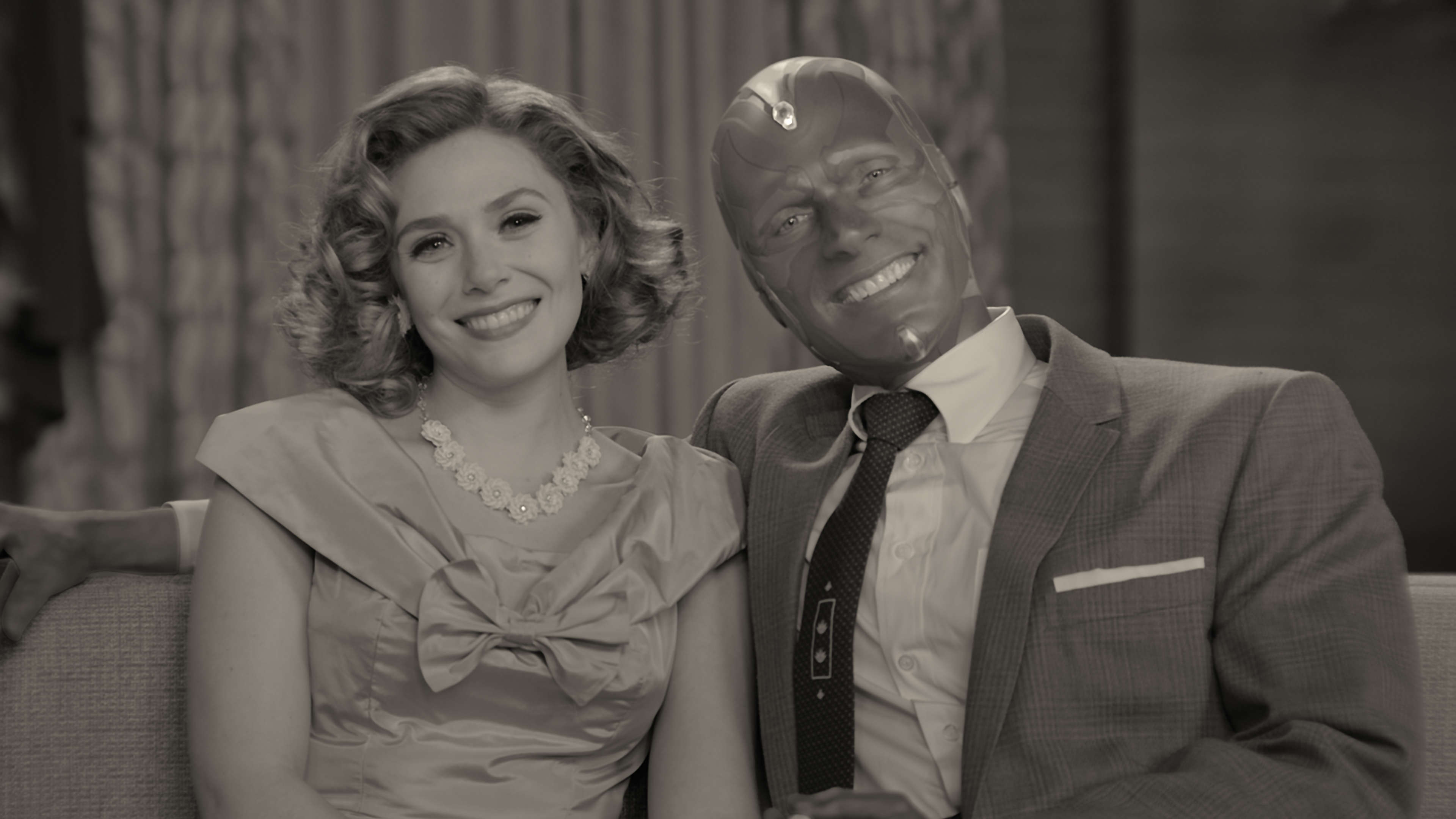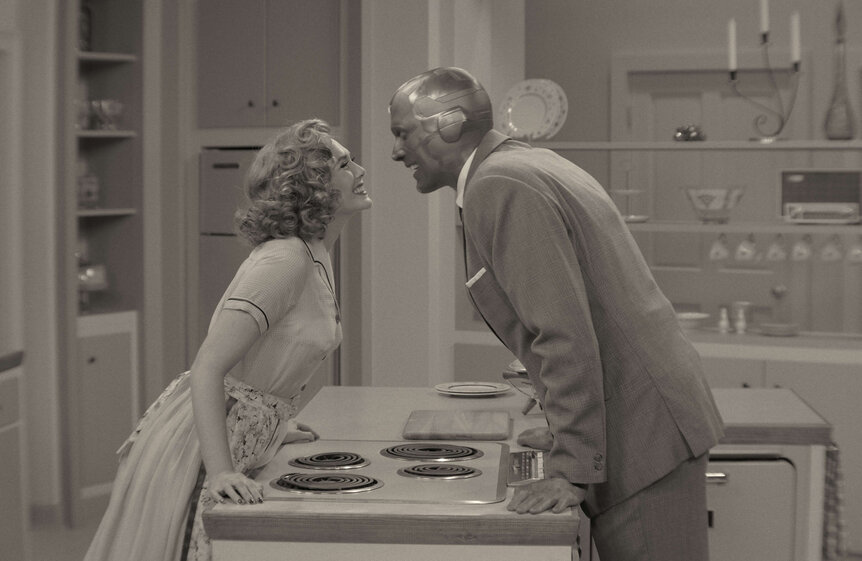Create a free profile to get unlimited access to exclusive videos, sweepstakes, and more!
WandaVision's best VFX were invisible (except for when they were supposed to look like Tron or Bewitched)

Ryan Freer, the visual effects supervisor for the VFX studio Monsters Aliens Robots Zombies (or MARZ), had to bite his tongue when he pursued Reddit threads midway through WandaVision's first season. It wasn't because Freer had the inside scoop on whether or not a particular fan theory was wrong or right, but because some Redditors were asking why the Disney+ show's visual effects budget was so big, seeing as there weren't really any spectacular visual effects in the first couple of episodes. Or at least, that's what they thought, because they didn't realize that essentially every scene with Vision in his true android form was a VFX feat, largely courtesy of MARZ.
"I didn't chime in or want to say anything. I just let people try to wrap their brains around it," Freer tells SYFY WIRE. "The best visual effects are visual effects. You don't notice."
As tends to be the case with big, VFX-heavy blockbusters or major TV shows such as the Marvel Cinematic Universe's latest entries, many, many VFX studios contributed to bringing WandaVision to life. MARZ, which was founded in 2018, is a fairly young studio, but it was partially tasked with one of the most important effects that many viewers would, hopefully, never notice.
"Most people, if they're not into visual effects or have done the research into how the previous movies have been made, they just, they just assume that Paul Bettany's wearing headgear and he's wearing makeup and that's all done in-camera, but it's not," Freer explains. Instead, with the exception of Bettany's eyes, nose, and some of his mouth, Vision's robotic head is a CGI creation. Ensuring that it never looks that way onscreen — especially under the harsh, unforgiving lights of a classic sitcom set — is a feat.
MARZ mainly works in TV. Prior to this, the studio's highest-profile effect was Looking Glass' mask in HBO's Watchmen series, another undertaking that many viewers might not have realized was CGI in the first place. Even so, the blockbuster Disney+ series didn't feel quite like doing special effects for television — at least not TV VFX as we used to think of them.
"Years ago, you'd think TV show-quality meant it's not feature film-quality. It's cheesy. It's not at the same level. But, nowadays it's, you're getting to the point where you're not really finding much of a difference, especially when you're working on something like a Marvel show," explains MARZ co-president Lon Molnar, although he notes that Marvel Studios offered them the room to go through 20 or 30, sometimes even up to 60 different iterations on an effect before settling on the final product.
That said, despite feeling more like a blockbuster movie than a typical TV show, and despite MARZ's goal of making its VFX work feel invisible, part of WandaVision's core conceit was that it had to seem like an old TV sitcom — and old TV sitcoms were not nearly as glossy and polished as a modern movie.
"We had to make feature film-level effects for a TV show that had to be at that level, but not look like it, but also look like a TV show, which is kind of confusing," Freer admits. One of the effects MARZ handled in the early and mid-season episodes was Vision's transformation from his human form to his android one. In the second episode, a riff on '60s sitcoms, Vision transforms with "a starry wipe" that's reminiscent of Bewitched, while for the episode that's set in a '70s-era show, Freer says they looked to Tron for "the lines and the really cheesy kind of glow you'd get back then."
Sometimes, in what could seem like anathema to the very idea of seamless visual effects, MARZ needed to make scenes look "worse," for lack of a better word. The early scene where Vision and Wanda have wedding rings appear on their hands was achieved using a jump-cut, a fairly simple film technique where the visuals abruptly cut from one bit of footage to another. Problem was, even this was too seamless for the old black and white sitcom vibes Marvel Studios was going for.
"It was too smooth," Freer explains. "So we actually had to move the frame around, take their hands, rotoscoped them out, moved them in the frame, and then replaced the background to make it look like more of a change, which is the opposite of what you ever want to do on a job."
Perhaps the flashiest effect MARZ did for the series, and the one Freer's the proudest of, was the scene in Episode 6, the Halloween one, when Vision flies up above Westview and then down to Agnes. The entire scene — the town, the sky, and all of Vision with the exception of just a few of Bettany's facial features, was CGI.
As a young studio, MARZ's ambitions and capabilities are growing. ("We're proving that we're good at heads," Molnar says.) Yet Freer is understanding — and perhaps even a little sympathetic — of criticisms that superhero movies always tend to end with a CGI extravaganza for a final act, and WandaVision's finale was no exception. (MARZ did not do effects work on the final battle, it should be noted.)
"That's kind of the way it goes where you kind of, you kind of have this massive finale where the 'beat 'em up' side of comic books comes out. I think it wouldn't be an epic big movie if you didn't," Freer says. "What I did think though, with this show is the amount of emotion that was attached to it. It wasn't like, 'Oh, we saved the world game over.' There were some actual emotions and feelings, and I think that's what people were attached to them the most. Maybe they didn't need to go so huge, but you kind of have to appease both sides of it."
In a way, the VFX that you probably didn't know were VFX are a counterpoint to any qualms you might have about big flashy endings. As MARZ's work on WandaVision shows, in the MCU — and in many blockbusters — the character beats and drama you might be more invested in than the VFX-heavy finales could be just as dependent on VFX.



























